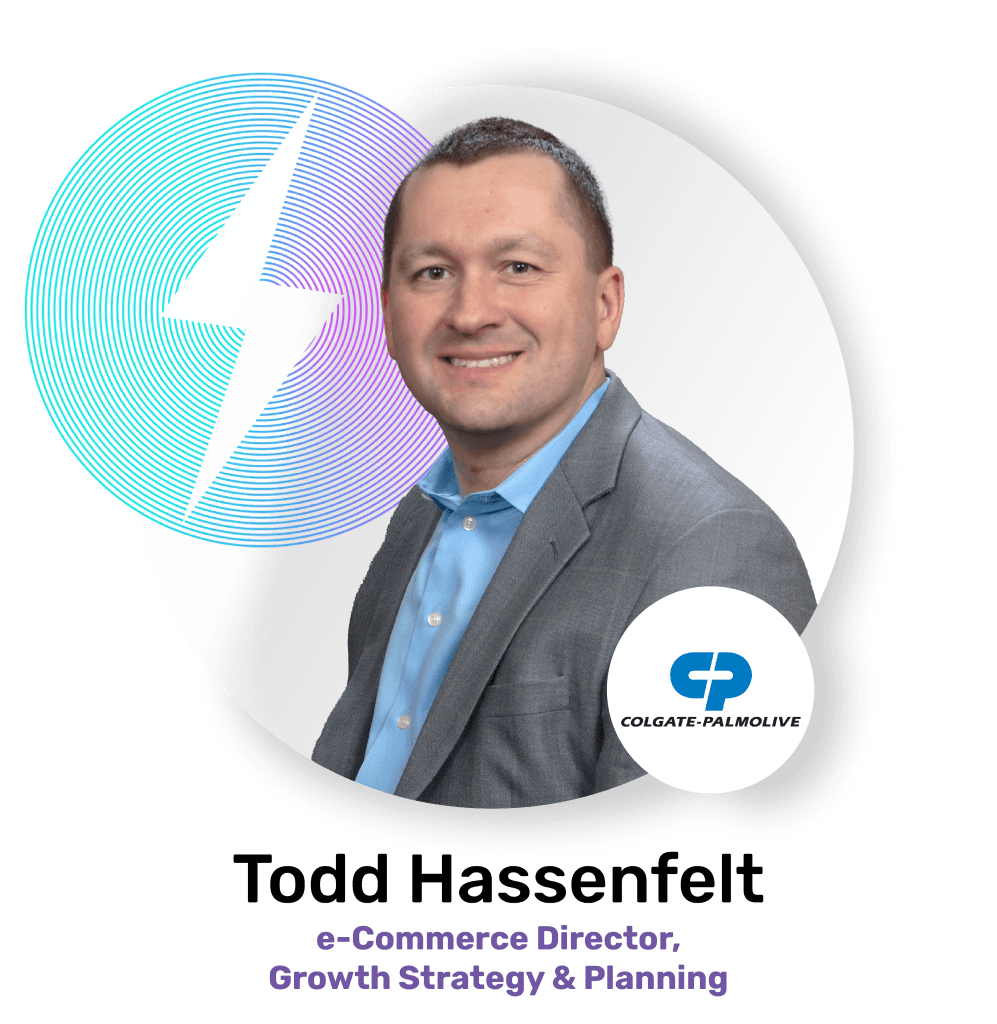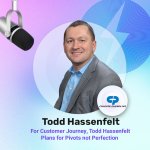Over the last few years, how consumers interact with brands has changed drastically. We went through a pandemic that skyrocketed e-commerce for most brands, and until now, we are still experiencing growth in digital transformation. In today’s episode, our guest Todd Hassenfelt, eCommerce Director, Growth Strategy & Planning at Colgate-Palmolive, shared his experience with the customer journey and the evolution of brand experiences. Listen to his episode to learn valuable insights about evolution, the consumer journey, and the ultimate balance of innovation and speed.

Guest
Todd Hassenfelt
KEY POINTS:
- Never stop evolving, learn from those around you
- Don´t find and excuse, find a solution
- Learn about what is going on before making changes
- Plan with flexibility to match the speed of the Now gen
- There is not only one consumer journey
- Meet your consumer where they are
RELEVANT QUOTES:
“I’ve been part of brands that have been number one in their category at the bottom of the category, in the middle, you know, fighting to be number one.”
“So I think that’s, you know, a really interesting perspective to see all the different, tactics and, and how you look at things depending where you are.”
“I’m really lucky, you know, no matter where I’ve been, I’ve had really, you know, talented colleagues that I could learn from, you know, supportive bosses, hiring managers, including my first e-comm job where I had no e-comm experience.”
“I think, you know, always looking for that challenge, continuous improvement, always, you know, you know, don’t find an excuse, find a solution.”
“It’s a balance of diving in and getting early wins, but yet observe and, you know, don’t, don’t make changes before you know why things are going on. So it’s, it’s kind of finding that balance.”
“E-comm or digital commerce teams are great at trying to connect the dots, right? So you have to bounce around to a supply chain meeting, to a legal meeting, to a sales meeting, to a marketing meeting, to a finance meeting. And yeah, you’re not gonna be the expert in all of those necessarily. But if you can help connect the dots both within those, and then how it comes together from, you know, more importantly, an omnichannel perspective.”
“A quote I use a lot is, things have never been this fast, and they’ll never be this slow again.”
“Speed has to come into it, and it comes into many, many type of conversations, whether we’re looking at innovation, whether you’re looking at information processing,”
“Don’t call yourself an expert. Call yourself like an evolver.”
“If you spend too much time in the planning portion, you’re, you’re, you’re gonna maybe miss the trends or the, the trends will change by the time you execute the plan or even launch the plan.”
“Now, it doesn’t mean speed should be careless either. There, there does need to be planning to a degree, but I think that’s where the plan for pivots comes into play, not perfection.”
“If we’re looking at different things, whether it’s digital shelf, retail, media, you know, innovation, how are we doing versus our competition? And even that, who is our competition really depends on the consumer.”
“When you look at e-commerce, very few of us have decades of experience of e-commerce, like we do brick and mortar. So you have to evolve. It’s not necessarily being an expert in it, it’s how are you evolving?”
“I think it’s about finding the strengths of where everyone is, and then give stretch goals to how they can improve. And everyone’s in different spots.”
“But when you think about the consumer journey, you could get caught up in channels or, you know, it’s, well, people are going back to brick and mortar, you know, now that covid is over. Well, they didn’t throw away their cell phones, they didn’t turn off their wifi.”
“The acronym is SAFA. The consumer journey starts anywhere, finishes anywhere.”
“If you think about it that way, hopefully, it kind of takes you out of, well, no, they go to this one store, or they just go online, or that it’s a whole thing. It’s social media, it’s out of home, it’s digital, it’s the in-store end cap. It’s price promotions. It really, it helps bring things together.”
“There’s not one journey, you know, that start anywhere, finish anywhere SAFA mentality. So if you think about it as safa, now, maybe you’re not as much, you know, maybe where wherever you have the most experience, whether it’s digital or whether it’s brick and mortar.”
“If you truly understand it, then you would think differently about how important a product detail page is. Because if you’re in a store and, and, and maybe the, maybe your product is a new product that they wanna learn about, but it’s behind a lock and key, or they just, there’s not enough information on the box and they wanna go on to the product detail page and see your bullet points to see, okay, what are the reasons to believe?”
“But they’re probably not as much as you’re physical in-store sales if you’re still separating these out. But now we’re seeing screens inside of stores, physical stores, right on end caps, on cooler doors, cell phone with the in-store navigation apps, smart carts, the typical screens they’ve had now that are repurposed for in-store retail media.”
“And I think now, if you start thinking about that PDP content showing up in a physical location, that’s really gonna change, or it should change mindsets of how we look at this.”
“Do we have the right reasons for the consumer? How are we helping solve for their everyday needs? Not just, let’s say product, benefits, but how do we help people?”
“I think whether it’s from a brand perspective or, or just in life, people, consumers, people tend to gravitate towards those who help either make their lives easier or quicker.”
“It’s not that every category in every brand needs to have, you know, less than 30 minutes speed. But for the ones that do, then absolutely how, and that’s more like, how do you solve a need for a consumer for those products that they truly need right now.”
“But I think there’s also another part of it, if you’re looking at, and this can be in store or online, but we can measure a little bit better from the online perspective, is being there at that moment where the consumer is.”
“They get the product, and depending where they’ve gotten from, and they’re probably making that choice ahead of time, but they get it in, you know, same day, one day.”
“So four different surveys, but all of them showed, from an online perspective, that is where people make more impulse buys, more higher percentage, just close, but a higher percentage than in stores. And I think that’s really interesting stat to share within an organization, right? Because a lot of times you’re like, oh, it’s the checkout, I’m not, you, you know, it’s, it’s, it’s a checkout kind of buys. And those are obviously still important, but I think this instant gratification comes in many forms.”
“Be where the consumer is, but know that’s multiple different thing, multiple different places and multiple different use cases for the consumer.”
“So you can put that into generative AI and think of different ways of optimizing, whether it’s based on, you know, the reviews of a page, what keywords are, you know, consumer trends.”
“But think about how many iterations you can get in literally a day or so, I know, versus how many months that would’ve taken.”
“Putting your brand name on there, or even showing your product correctly, we’re still not there. I’ve seen maybe one instance that’s getting close and, and, and listen, by the time this podcast launches, maybe they’ll be updated already. So this stuff’s moving so far. “
“You could launch it in, you could, you could release this in an hour, and it could be outdated. But, um, but I think from an image standpoint, it’s like gen AI is not there yet.”
“But I think, you know, I think about just how people do or, respond to, you know, chatbots, let’s say, or an automated on the phone. We all know to press zero, right? To try and get to a human.”
“I think from an efficiency standpoint, it’s really interesting. But then another part, you know, even with public models is how you look at competitive comparisons.”
“You could just have someone kind of use this incredibly patient chat GPT to ask as many questions as you want at any point of day versus trying to, you know, call someone or email someone, um, at least initially. And of course, it always has to be a balance, but I think that onboarding could be really interesting.”
“I’ll kind of go with three of the things I talked about, plan for pivots. So no matter what the topic is or department you’re in, so plan for pivots, not perfection.”
“Change has never, change has never been this fast before. It’ll never be this slow again, if you just accept change is not going to slow down. “
“I think no matter the topic, no matter the company that you’re in, no matter how consumer trends change, you have the best chance to adapt and really be helpful to as many people as possible.”
“Because really we’re all learning this together. None of us are experts. We’re all just learning evolves.”

